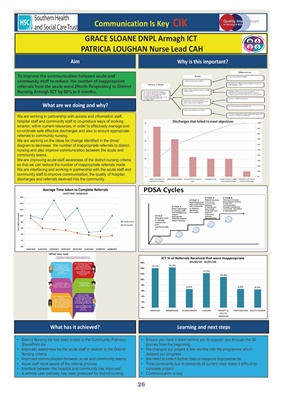
Communication Is Key CIK
GRACE SLOANE DNPL Armagh ICT
PATRICIA LOUGHAN Nurse Lead CAH
Why is this important?
Learning and next steps
Aim
What has it achieved?
What are we doing and why?
We are working in partnership with access and information staff,
hospital staff and community staff to co-produce ways of working
smarter, within current resources, in order to effectively manage and
co-ordinate safe effective discharges and also to ensure appropriate
referrals to community nursing.
We are working on the ideas for change identified in the driver
diagram to decrease the number of inappropriate referrals to district
nursing and also improve communication between the acute and
community teams.
We are improving acute staff awareness of the district nursing criteria
so that we can reduce the number of inappropriate referrals made.
We are interfacing and working in partnership with the acute staff and
community staff to improve communication, the quality of hospital
discharges and referrals received into the community.
To improve the communication between acute and
community staff to reduce the number of inappropriate
referrals from the acute ward 2North Respiratory to District
Nursing Armagh ICT by 80% in 6 months.
• District Nursing tile has been added to the Community Pathway
SharePoint tile
• Improved awareness for the acute staff in relation to the District
Nursing criteria
• Improved communication between acute and community teams.
• Acute staff more aware of the referral process
• Interface between the hospital and community has improved
• A service user pathway has been produced for district nursing.
• Ensure you have a team behind you to support you through the QI
journey from the beginning.
• We changed our project a few months into the programme which
delayed our progress.
• We need to collect further data to measure improvements.
• Time constraints due to demands of current roles made it difficult to
complete project.
• Communication is key
Discharges that failed to meet objectives
26